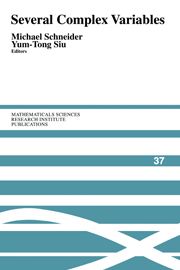Book contents
- Frontmatter
- Contents
- Preface
- Local Holomorphic Equivalence of Real Analytic Submanifolds in ℂN
- How to Use the Cycle Space in Complex Geometry
- Resolution of Singularities
- Global Regularity of the ∂-Neumann Problem: A Survey of the L2-Sobolev Theory
- Recent Developments in the Classification Theory of Compact Kahler Manifolds
- Remarks on Global Irregularity in the ∂-Neumann Problem
- Subelliptic Estimates and Finite Type
- Pseudoconvex-Concave Duality and Regularization of Currents
- Complex Dynamics in Higher Dimension
- Attractors in ℙ2
- Analytic Hilbert Quotients
- Varieties of Minimal Rational Tangents on Uniruled Projective Manifolds
- Recent Developments in Seiberg-Witten Theory and Complex Geometry
- Recent Techniques in Hyperbolicity Problems
- Rigidity Theorems in Kahler Geometry and Fundamental Groups of Varieties
- Nevanlinna Theory and Diophantine Approximation
Pseudoconvex-Concave Duality and Regularization of Currents
Published online by Cambridge University Press: 25 June 2025
- Frontmatter
- Contents
- Preface
- Local Holomorphic Equivalence of Real Analytic Submanifolds in ℂN
- How to Use the Cycle Space in Complex Geometry
- Resolution of Singularities
- Global Regularity of the ∂-Neumann Problem: A Survey of the L2-Sobolev Theory
- Recent Developments in the Classification Theory of Compact Kahler Manifolds
- Remarks on Global Irregularity in the ∂-Neumann Problem
- Subelliptic Estimates and Finite Type
- Pseudoconvex-Concave Duality and Regularization of Currents
- Complex Dynamics in Higher Dimension
- Attractors in ℙ2
- Analytic Hilbert Quotients
- Varieties of Minimal Rational Tangents on Uniruled Projective Manifolds
- Recent Developments in Seiberg-Witten Theory and Complex Geometry
- Recent Techniques in Hyperbolicity Problems
- Rigidity Theorems in Kahler Geometry and Fundamental Groups of Varieties
- Nevanlinna Theory and Diophantine Approximation
Summary
We investigate some basic properties of Finsler metrics on holomorphic vector bundles, in the perspective of obtaining geometric versions of the Serre duality theorem. We establish a duality framework under which pseudoconvexity and pseudoconcavity properties get exchanged — up to some technical restrictions. These duality properties are shown to be related to several geometric problems, such as the conjecture of Hartshorne and Schneider, asserting that the complement of a q-codimensional algebraic subvariety with ample normal bundle is q-convex. In full generality, a functorial construction of Finsler metrics on symmetric powers of a Finslerian vector bundle is obtained. The construction preserves positivity of curvature, as expected from the fact that tensor products of ample vector bundles are ample. From this, a new shorter and more geometric proof of a basic regularization theorem for closed (1,1) currents is derived. The technique is based on the construction of a mollifier operator for plurisubharmonic functions, depending on the choice of a Finsler metric on the cotangent bundle and its symmetric powers.
Introduction
The goal of the present paper is to investigate some duality properties connecting pseudoconvexity and pseudoconcavity. Our ultimate perspective would be a geometric duality theory parallel to Serre duality, in the sense that Serre duality would be the underlying cohomological theory. Although similar ideas have already been used by several authors in various contexts — for example, for the study of direct images of sheaves [Ramis et al. 1971], or in connection with the study of Fantappie transforms and lineal convexity [Kiselman 1997], or in the study of Monge-Ampere equations [Lempert 1985]—we feel that the “convex-concave” duality theory still suffers from a severe lack of understanding.
Information
- Type
- Chapter
- Information
- Several Complex Variables , pp. 233 - 272Publisher: Cambridge University PressPrint publication year: 2000
